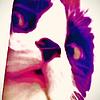You need to sign in or sign up before continuing.
Take a photo of a barcode or cover

babeeyaga 's review for:
A Humument: A Treated Victorian Novel
by Tom Phillips
This is a hard one to rate, and I have a feeling my opinion will change overtime. The author’s goal — of taking the techniques used in erasure poetry to craft a novel out of an existing text — is incredibly ambitious, and the idea itself makes this work admirable.
It’s difficult to say whether the author was successful. Reading this reminded me of “The Waste Land,” as it hints toward a narrative and characters, but never enough to actually fully follow what is “happening,” at least not without many, many rereads. Because I personally love “The Waste Land,” I enjoyed engaging with a text that messes with our understanding of how a novel can be written. There is some truly gorgeous verse in this book. But when I did try to engage with the text like I would with a typical novel, I found it to be frustrating. I know this is kinda of the nature of non-linear narratives, and I occasionally see some of the characters and story come through. But I just felt like there was something missing when it came to connecting these pages as a collective story rather than a book of poetry.
While the nature of this art form makes this book’s word-count short, I still felt like there was an issue of quantity over quality. Sadly, many pages felt like repetitions of one another. I felt like much of the text that was poignant (exploring sexuality, loneliness, love, etc.) got lost in when other weaker sections retreaded the same ground.
The author apparently displayed the pages in a gallery first, and that makes sense. The scale of what he created is likely more powerful as a physical display rather than having all the pages bound together as a singular story. And that maybe sums up how I feel about this book: wonderful art, and a some what successful attempt at a novel.
It’s difficult to say whether the author was successful. Reading this reminded me of “The Waste Land,” as it hints toward a narrative and characters, but never enough to actually fully follow what is “happening,” at least not without many, many rereads. Because I personally love “The Waste Land,” I enjoyed engaging with a text that messes with our understanding of how a novel can be written. There is some truly gorgeous verse in this book. But when I did try to engage with the text like I would with a typical novel, I found it to be frustrating. I know this is kinda of the nature of non-linear narratives, and I occasionally see some of the characters and story come through. But I just felt like there was something missing when it came to connecting these pages as a collective story rather than a book of poetry.
While the nature of this art form makes this book’s word-count short, I still felt like there was an issue of quantity over quality. Sadly, many pages felt like repetitions of one another. I felt like much of the text that was poignant (exploring sexuality, loneliness, love, etc.) got lost in when other weaker sections retreaded the same ground.
The author apparently displayed the pages in a gallery first, and that makes sense. The scale of what he created is likely more powerful as a physical display rather than having all the pages bound together as a singular story. And that maybe sums up how I feel about this book: wonderful art, and a some what successful attempt at a novel.